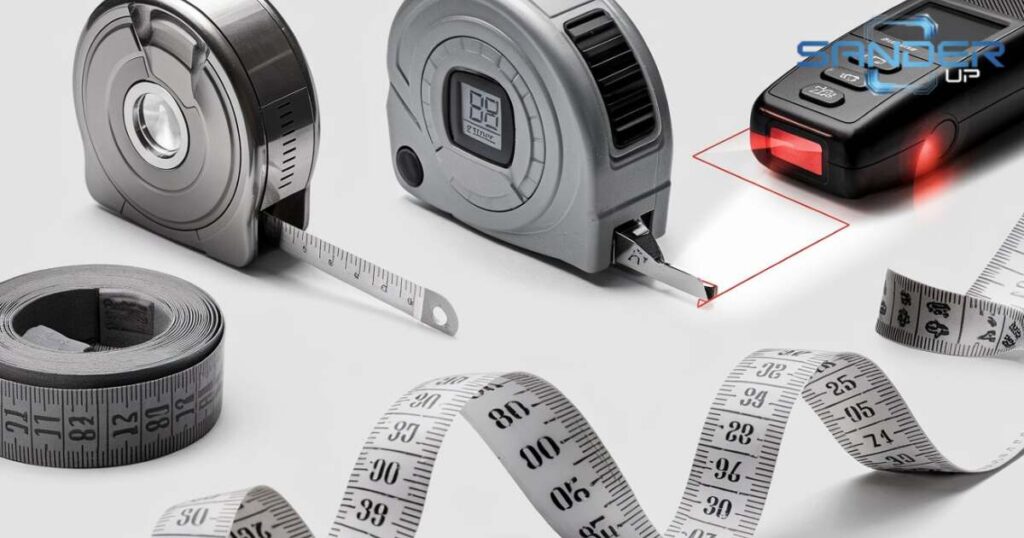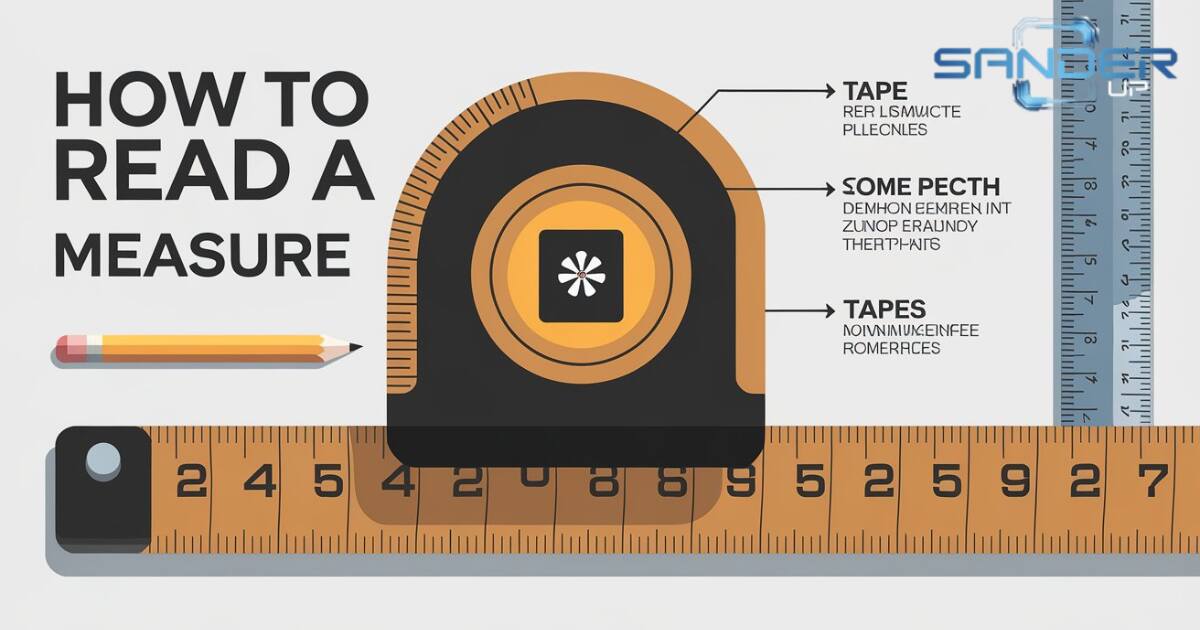A tape measure is a simple tool used to measure length. It has markings that show inches, feet, and sometimes centimeters.
Start by pulling out the tape until it reaches the point you want to measure. The numbers on the tape represent the length. Whole numbers represent inches, while the smaller lines between them are fractions of an inch.
For more precise measurements, look at the lines between the numbers. The longest lines represent 1/2 inch, the next longest are 1/4 inch, and the shortest lines represent 1/8 or 1/16 inch.
With practice, you’ll get better at reading a tape measure quickly and accurately.
Understanding Tape Measures
Tape measures come in two main systems: metric and imperial. The metric system measures in millimeters, centimeters, and meters, while the imperial system uses inches and feet. Many tape measures include both systems, making them versatile for different tasks.
Metric vs. Imperial Systems
The metric system is commonly used in most parts of the world. It’s based on multiples of 10, making it easier for some people to understand. The imperial system, widely used in the U.S., uses inches and feet. One inch equals 2.54 centimeters.
Essential Parts of a Tape Measure
A tape measure has several important parts. The blade is the retractable strip marked with measurements. The hook at the end helps hold the tape in place. There’s also a lock to keep the blade extended when needed. The case houses the tape and protects it from damage.
Anatomy of a Tape Measure
The tape measure’s blade contains markings for both systems. The case is often made of durable plastic or metal. The hook at the end is usually loose to account for the thickness of the hook itself, ensuring accurate measurements whether you push or pull.
How to Measure Using a Tape Measure
Using a tape measure is simple, but understanding the markings is key to accurate measurements. The different lines and marks help you take precise measurements.
Reading the Tape Measure Lines & Marks
The numbers on a tape measure represent whole inches, while the lines between them show fractions. The longest lines are for 1/2 inches. The next longest represent 1/4 inches. Smaller lines show 1/8 and 1/16 inches. In metric tape measures, lines represent millimeters and centimeters.
Stud Marks
Many tape measures have special marks at regular intervals, usually every 16 inches. These are called stud marks. They are useful for finding the distance between studs in walls, which is important in construction.
Self-Centering Marks
Some tape measures feature self-centering marks. These marks help you easily find the center of a measurement. This is especially useful when you need to split a space or object into equal halves without doing the math yourself.
Tape Measure Tips
There are a few handy tricks that can help you make the most of your tape measure. These tips can save time and improve accuracy.
No More Bending the Tape:
When measuring longer distances, avoid bending the tape. Instead, use the locking mechanism to hold it steady. This will keep the tape straight and prevent inaccurate measurements.
The Wiggly Hook is Intentional:
The hook at the end of a tape measure may seem loose, but this is on purpose. It moves slightly to adjust for its thickness, ensuring accurate measurements whether you push or pull.
Easily Measure a Perfect Circle:
To measure a circle, hook the tape at the center point, extend the tape to the edge, and then rotate it around. This will give you the diameter. Multiply by two to get the circumference.
Use the Same Measuring Tape:
For the best consistency, always use the same tape measure for a project. Different tape measures can vary slightly, leading to small but important differences.
Try a Digital Tape Measure:
A digital tape measure can make measuring faster and more precise. It displays the measurement on a screen, reducing the chance of errors, and some models even store measurements for you.
Types of Tape Measures

Tape measures come in various types designed for different uses and environments. Here are some of the most common types:
1. Pocket (Retractable) Tape Measure
- Use: General construction, DIY projects, and home use.
- Description: The most common type, housed in a compact case, with a retractable metal or fiberglass blade. Lengths usually range from 3 to 25 feet (1 to 7.5 meters).
- Features: Locking mechanism, hook for measuring.
2. Surveyor’s Tape Measure
- Use: Used in land measurement, construction, and surveying.
- Description: Typically much longer than pocket tapes (30 to 300 feet or more). Made of fiberglass or steel and housed in an open reel or closed case.
- Features: May have a handle for winding and a durable design for outdoor use.
3. Sewing Tape Measure (Tailor’s Tape)
- Use: Tailoring, sewing, and body measurements.
- Description: A flexible cloth or fiberglass tape, usually 60 inches (150 cm) long. It’s soft and flexible, making it ideal for curved surfaces and body measurements.
- Features: Double-sided markings (inches on one side, centimeters on the other).
4. Steel Tape Measure
- Use: Professional construction, engineering, and high-precision work.
- Description: Made of durable steel for accurate measurements. Comes in both closed and open reel designs.
- Features: Extremely durable and resistant to stretching, usually for longer measuring lengths.
5. Laser Tape Measure
- Use: Construction, interior design, real estate.
- Description: A digital device that uses a laser beam to measure distances. These are often used in large spaces or when measuring hard-to-reach areas.
- Features: Display screen, can measure distances up to several hundred feet/meters.
6. Digital Tape Measure
- Use: Ideal for people needing a quick digital reading, such as woodworkers or contractors.
- Description: A tape measure with a built-in digital display that gives instant readings of measurements.
- Features: Digital interface, memory function, and sometimes laser capabilities.
7. Open Reel Tape Measure
- Use: Landscaping, construction, agriculture.
- Description: A long tape (typically 50 to 300 feet or more), usually made of fiberglass, steel, or other tough materials, housed in an open reel frame.
- Features: Hand crank for easy rewinding, durable materials for outdoor work.
8. Magnetic Tape Measure
- Use: Construction and metalworking.
- Description: A standard retractable tape measure with a magnetic hook at the end, allowing it to attach to metal surfaces.
- Features: Useful for hands-free measurements on steel and other metal surfaces.
9. Keychain Tape Measure
- Use: Lightweight, portable, and for minor tasks.
- Description: A miniature version of the retractable tape measure, often attached to a keychain. Typically no more than 3 feet (1 meter).
- Features: Compact and easily portable.
10. Pipe Measuring Tape
- Use: Plumbing, measuring diameters of pipes or round objects.
- Description: A flexible tape designed to wrap around cylindrical objects, often marked with both linear measurements and diameter equivalents.
- Features: Specialized for circular measurements.
5 Tape Measure Hacks & Tips
Here are five clever hacks and tips to improve your measuring skills and efficiency with a tape measure.
1. Use the 1-Inch Mark for Accurate Measurements
Instead of starting from the very end of the tape measure, use the 1-inch mark as a starting point. This helps avoid errors caused by the tape’s hook and ensures more accurate measurements.
2. Mark with a Pencil or Marker
When taking measurements, use a pencil or marker to make small marks at measurement points. This helps prevent mistakes and allows for easy visibility when cutting or aligning materials.
3. Use the Tape for Measuring Angles
You can measure angles easily by folding the tape measure into an L-shape. Align the edges of the tape with the surfaces you’re measuring to get accurate angle measurements without needing a protractor.
4. Store the Tape Measure in a Tool Belt
Keep your tape measure easily accessible by storing it in a tool belt or pouch. This not only prevents it from getting lost but also saves time when you need to grab it quickly.
5. Create a Measuring Board
If you often measure similar items, consider making a measuring board. Attach a tape measure along the edge of a flat board. This makes it easy to line up items and measure quickly without having to extend the tape each time.
Frequently Asked Questions
What tape measure is easiest to read?
A tape measure with large, bold numbers and a bright, contrasting background is easiest to read. Some models also have wider markings for feet and inches, which can help.
How do you read a 12 inch tape measure?
To read a 12-inch tape measure, start at the “0” end. Each inch is marked, with smaller lines indicating fractions (1/4, 1/8, 1/16). Count the inches and look for the smaller lines to get precise measurements.
What are the little lines between inches?
The little lines between inches on a tape measure represent fractions of an inch. Typically, there are:
- 1/4 inch: One long line between each inch.
- 1/8 inch: Two shorter lines between each quarter inch.
- 1/16 inch: Four very short lines between each eighth inch.
These markings help provide more precise measurements.
What do the lines on a tape measure mean?
The lines on a tape measure indicate different measurements:
- Long lines: Each represents one full inch.
- Medium lines: Usually mark 1/2 inch.
- Short lines: Indicate 1/4, 1/8, and 1/16 inches, with the longest short lines marking 1/4 inch.
These lines help measure with precision.
How to use a tape measure correctly?
To use a tape measure correctly, follow these steps:
- Extend the tape: Pull out the tape measure to the desired length.
- Secure the end: Place the end hook against the starting point of your measurement.
- Read the measurement: Look at where the tape meets the object. Note the nearest inch and any fractional lines.
- Record the measurement: Write down the value for reference.
Why is there ‘play’ in the end hook of FREEMANS Measuring Tapes?
The “play” in the end hook of Freemans measuring tapes allows for accurate measurements. This design accounts for the thickness of the hook. When measuring from the hook’s inside edge, the play compensates, ensuring the tape measures the true distance accurately.
What is the house shaped mark printed at the 16” graduation line on FREEMANS Measuring Tapes?
The house-shaped mark at the 16-inch graduation line on Freemans measuring tapes indicates the standard spacing for wall studs in construction. This mark helps builders quickly identify where to place nails or screws for framing, making it easier to ensure accurate spacing.
Which measurement units should I be familiar with?
You should be familiar with the following measurement units:
- Inches (in): Commonly used for smaller measurements.
- Feet (ft): Used for larger lengths; 1 foot equals 12 inches.
- Centimeters (cm): Part of the metric system; useful for precise measurements.
- Meters (m): Larger metric unit; 1 meter equals 100 centimeters.
Where can I see a 1-foot marking on my tape blade?
You can find the 1-foot marking on your tape measure usually after the 12-inch markings. It is typically indicated by a longer line or a special symbol, often at the beginning of the second foot. Look for it just after the first 12 inches on the tape blade.
What is a SOOT?
A SOOT, or “Statement of Outstanding Tax,” is a document that outlines any outstanding tax liabilities owed by an individual or entity. It serves as an official record of taxes that are unpaid, helping to clarify financial responsibilities.
Summary
Tape measures are essential tools used for measuring length and distance. They come in various types, including cased tape measures, open reel tape measures, diameter tape measures, and sewing tape measures, each serving specific purposes. Understanding the difference between metric and imperial systems is crucial for accurate measurements.
To read a tape measure, familiarize yourself with the markings and lines that indicate inches, feet, and fractions. Tips for using tape measures include avoiding bending, utilizing the intentional wiggle of the hook, and measuring circles effectively. Consistency is key, so using the same tape for a project is advisable.
Five handy hacks can further improve your measuring efficiency. Start from the 1-inch mark for accuracy, use marks to indicate measurement points, and utilize the tape for measuring angles. Storing the tape in a tool belt makes it easily accessible, while a measuring board can speed up repetitive tasks. With these insights and tips, you can master the art of measuring with a tape measure.











